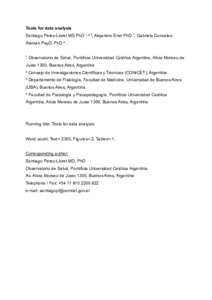Por favor, use este identificador para citar o enlazar este ítem:
https://repositorio.uca.edu.ar/handle/123456789/19079| Campo DC | Valor | Lengua/Idioma |
|---|---|---|
| dc.contributor.author | Pérez Lloret, Santiago | es |
| dc.contributor.author | Enet, Alejandro | es |
| dc.contributor.author | Gonzalez Aleman, Gabriela | es |
| dc.date.accessioned | 2024-11-22T12:25:35Z | - |
| dc.date.available | 2024-11-22T12:25:35Z | - |
| dc.date.issued | 2024 | - |
| dc.identifier.issn | 2330-1619 (online) | - |
| dc.identifier.uri | https://repositorio.uca.edu.ar/handle/123456789/19079 | - |
| dc.description.abstract | What are statistics Good for in human research studies? Studies conducted on human beings may have different objectives and designs, but they all share some common principles. 1 We outline these principles as a cycle, shown in Figure 1. The first step is to obtain a sample from a population. A population is a group of human beings sharing one or more characteristics. In medical research, researchers usually define populations following a disease or a condition. Obtaining the sample is called “sampling”. 2 Researchers will then discuss the study with the potential participants. They will be part of the study sample if they accept to participate and fulfill all inclusion and exclusion criteria. Investigators will perform a series of procedures and assessments and may apply an intervention to the sample of participants. For example, a treatment may be used, and its effects on Parkinson’s Disease motor symptoms may be recorded. Notably, study results only represent the effects of the intervention on the sample of participants. However, researchers are generally interested in “extrapolating” these results to the target population. The “statistical inference” procedure allows for performing such extrapolations. 3 Statistics is the science of collecting, analyzing, and describing data to conclude a particular phenomenon based on a relatively limited sample material. 3 It employs mathematical and probabilistic tools to develop methods and models for data analysis... | es |
| dc.format | application/pdf | es |
| dc.language.iso | eng | es |
| dc.publisher | Wiley | es |
| dc.rights | Atribución-NoComercial-CompartirIgual 4.0 Internacional | * |
| dc.rights.uri | http://creativecommons.org/licenses/by-nc-sa/4.0/ | * |
| dc.source | Movement Disorders Clinical Practice. 2024 | es |
| dc.subject | ESTADISTICAS | es |
| dc.subject | ANALISIS DE DATOS | es |
| dc.title | Tools for data analysis | es |
| dc.type | Artículo | es |
| dc.identifier.doi | 10.1002/mdc3.14092 | - |
| dc.identifier.pmid | 38863258 | - |
| uca.disciplina | MEDICINA | es |
| uca.issnrd | 0 | es |
| uca.affiliation | Fil: Pérez Lloret, Santiago. Pontificia Universidad Católica Argentina. Observatorio de Salud Publica; Argentina | es |
| uca.affiliation | Fil: Pérez Lloret, Santiago. Consejo de Investigaciones Científicas y Técnicas; Argentina. | es |
| uca.affiliation | Fil: Pérez Lloret, Santiago. Universidad de Buenos Aires. Facultad de Medicina. Departamento de Fisiología; Argentina | es |
| uca.affiliation | Fil: Enet, Alejandro. Pontificia Universidad Católica Argentina. Observatorio de Salud Publica; Argentina | es |
| uca.affiliation | Fil: Gonzalez Aleman, Gabriela. Pontificia Universidad Católica Argentina. Facultad de Psicología y Psicopedagogía,; Argentina | es |
| uca.version | publishedVersion | es |
| item.fulltext | With Fulltext | - |
| item.grantfulltext | open | - |
| item.languageiso639-1 | en | - |
| crisitem.author.dept | Laboratorio de Neurobiología Molecular | - |
| crisitem.author.dept | Consejo Nacional de Investigaciones Científicas y Técnicas | - |
| crisitem.author.dept | Facultad de Psicología y Psicopedagogía | - |
| crisitem.author.dept | Centro de Investigaciones en Psicología y Psicopedagogía (CIPP) | - |
| crisitem.author.orcid | 0000-0001-9069-6512 | - |
| crisitem.author.parentorg | Instituto de Investigaciones Biomédicas - BIOMED | - |
| crisitem.author.parentorg | Pontificia Universidad Católica Argentina | - |
| crisitem.author.parentorg | Facultad de Psicología y Psicopedagogía | - |
| Aparece en las colecciones: | Artículos | |
Ficheros en este ítem:
| Fichero | Descripción | Tamaño | Formato | |
|---|---|---|---|---|
| tools-data-analysis.pdf | 628,79 kB | Adobe PDF |  Visualizar/Abrir | |
| mdc3.jpg | 123,19 kB | JPEG | Visualizar/Abrir |
Este ítem está sujeto a una Licencia Creative Commons

